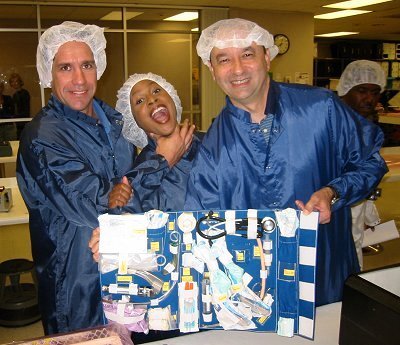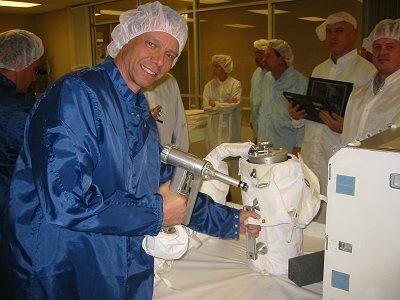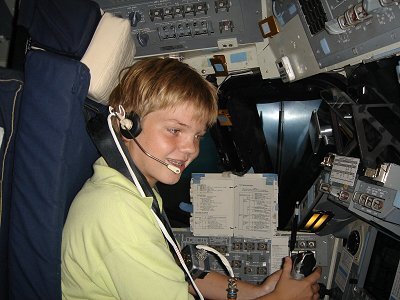Christer Fuglesang’s newsletter - Houston, 9 November 2006
Hi,
Today Discovery rolled out to the launchpad. She is now standing ready for the final preparations, which amongst other things include our dress rehearsal of the ignition day itself: the so called TCDT (Terminal Count Down Test) that will take place on Thursday next week.
The first lift-off date is still scheduled for 7 December, after a week of discussions about whether we could change the lift-off to 6 December or not; but at least we avoid the extra complications – above all for family and friends who are planning to attend the launch.
The trip has now been officially extended to 12 days. We have really reckoned with having an extra 24 hours the whole time, but now certain new demands have occurred which meant that we formally needed to be given an extra day.
The Space Shuttle's heat-shield will be inspected even before the landing and that takes up a lot of the crew's time. So that we don’t break the shift schedule regulations (there are rules governing working practices even for astronauts!) we were forced to add one day between undocking and landing.
The consequence, I think, is that we can't try to launch on more than two consecutive days. After that one day needs to be used for, amongst other things, topping up the oxygen tanks (the oxygen evaporates away slowly when you are standing on the ground waiting and, as it provides our electricity on the Shuttle, it is necessary to have the tanks full). After topping up the oxygen tanks the launch procedures can be resumed. If any problem occurs during the actual time at the ISS, then it is likely that the extra day would be moved forward and we would nevertheless have to work a good deal of 'overtime' after undocking.
Repeated studies and experiments after the Columbia incident indicate that the biggest risk of losing the Space Shuttle is if it is hit by a micro-meteorite, or smaller type of space debris, so unfortunately that a hole in the heat-shield results. At the same time the methods for reparing such damage have been improved, so it has now been decided that all flights from now on should include at least in the basic schedule such a type of 'late inspection' (in NASA-lingo).
Here is a link to the new flight-plan: Flight-plan (pdf 73 Kb).
One line per day, so called flight day(s) (FD). As you can see there are 13 flight days, but the actual flight duration is not more that 11 days 18 hours and 17 minutes. If we land at the first attempt. If the weather is bad then we might have to wait up to two more days in space. The time used onboard is called MET (Mission Elapsed Time – i.e. the time after the launch) and has the format day/hour:min:sec. A weird consequence is that we can be into, for example, flight day 3, but MET displays only 1 day. On the ISS one follows UTC (or GMT); on top of that launch- and landing times are often given in local Florida-time, which is 6 hours after Swedish time and sometimes even Houston-time is used, which is another hour after. So you have to know which time you are talking about!
The flight-plan shows an overview of what the crew will be doing and, when we are docked, also the Space Station's crew. ATT stands for attitude and means our spatial positioning. MCC is Mission Control Centre.
During the last few days we have carried out the final major simulations: one simulation was the landing day and the other was the launch day. In both cases we had the orange suits on.

Last Monday was the main PR-day, with press conferences at NASA all day and masses of individual interviews with all of the major American media agencies.
ESA and Rymdstyrelsen (The Swedish National Space Board) had organised a direct link to Stockholm where a large proportion of the Swedish media followed everything that was going on during the whole of the afternoon and half of the night.
It is fantastic what amount of interest there is! For me it meant five and a half hours of continuous press conferences and interviews, so I have to admit that I was a bit tired when it all was over; but now all the major PR is done – until after the launch (for better or worse).

We have even had the major 'bench review', which is a review of all the things that will be onboard with us for the flight. This is everything from cameras, computer cables and tools for the spacewalks to medicines, food, toiletries and clothes.
We checked that the equipment looked like we expected it to and that it was packaged and labelled in an understandable way. Sometimes we requested certain changes or wrote extra notation ourselves.

This afternoon the crew were able to show their families the Space Shuttle simulator and they also had a chance to go for a ride. It is a special honour that NASA offer once for every crew.
After a quick demonstration on how to interpret the steering indicators both Lisa and Rutger succeeded in landing the Space Shuttle intact.
Next week: Florida Monday – Thursday (TCDT) and spacewalk number two in the pool on Friday.
Best wishes,
Christer




